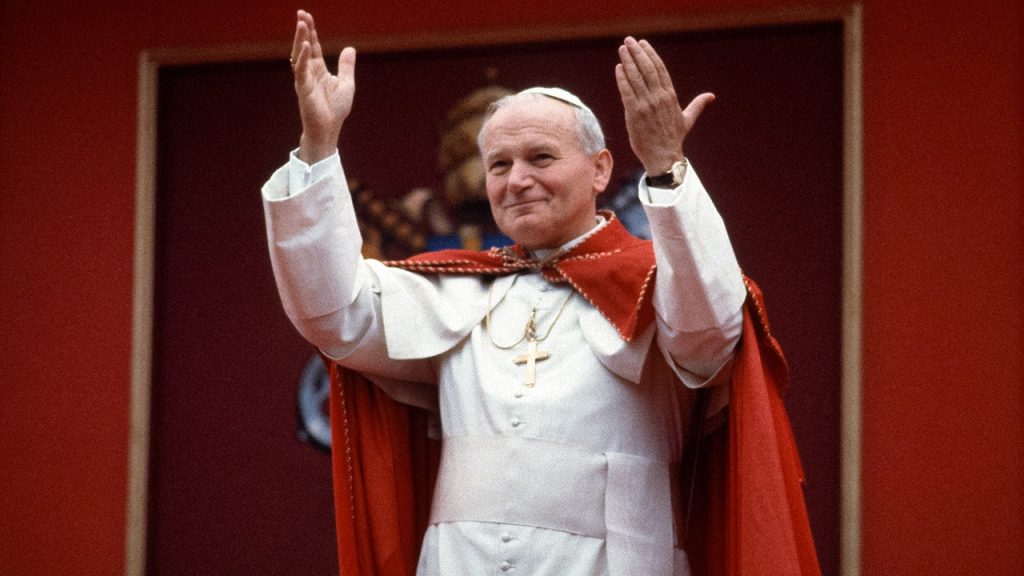Pope John Paul II arrived in Miami, Florida, on Sept. 10, 1987, to begin a 10-day tour of the United States. Thousands of well-wishers greeted him, including President Ronald Reagan and first lady Nancy Reagan. He delivered remarks emphasizing justice, peace, and human solidarity, as he embarked on his seventh visit to the U.S. during his nearly 27-year papacy. During his time in Miami, the pope met with representatives from various religious groups, attended events of significance, and celebrated an outdoor Mass at Tamiami Park in front of a crowd of over 200,000 people. The theme of the visit was unity and multiculturalism, exemplified by Cuban flags, Polish Solidarity banners, and music in various languages.
Following his visit to Miami, Pope John Paul II traveled to several other cities in the U.S., including Columbia, South Carolina; New Orleans; San Antonio; Phoenix; Los Angeles; Monterey; San Francisco; and Detroit. Noteworthy events during this trip included addressing Black Catholics in New Orleans, participating in an ecumenical conference in South Carolina, celebrating Mass in San Antonio with a large crowd, attending the Tekakwitha Conference of Native American Catholics in Phoenix, and engaging with representatives from the communications industry in Los Angeles. The pope’s dedication to unity, peace, and dialogue with people of all faiths was evident throughout his travels.
Born as Karol Wojtyla in Poland in 1920, Pope John Paul II was elected as the head of the Catholic Church in 1978 and served until his death in 2005. As a pope of many firsts, he was the first non-Italian pope in centuries and the most traveled pope in history, visiting 129 countries, including Cuba and Haiti. He broke barriers by visiting diverse religious sites, such as synagogues, mosques, and the Western Wall in Jerusalem, and engaging with leaders of various faiths. His efforts to end communism, promote peace, and seek reconciliation with other faith communities left a lasting impact on the global Catholic Church and beyond.
On April 2, 2005, Pope John Paul II passed away at the age of 84 at his home in the Vatican. His funeral six days later drew two million mourners to Vatican City. Known for his role in ending communism, building interfaith bridges, and issuing apologies for historical wrongs, the pope was succeeded by Pope Benedict XVI. Later, Pope Francis succeeded Pope Benedict in 2013 and canonized John Paul II in 2014, recognizing his significant contributions to the Catholic Church and the world. Pope John Paul II’s legacy of peace, reconciliation, and dialogue continues to inspire people of all faiths and backgrounds globally.
In addition to his profound impact on the Catholic Church, Pope John Paul II’s visits to the U.S. and other countries highlighted his commitment to unity, justice, and peace. His historic trips to various cities in the U.S. demonstrated his dedication to engaging with diverse communities, promoting dialogue among different religious groups, and advocating for social justice issues. By participating in events with priests, representatives of the Jewish community, Black Catholics, Native American Catholics, and other groups, the pope emphasized the importance of inclusivity, solidarity, and mutual respect among people of all backgrounds.
Overall, Pope John Paul II’s visit to Miami in 1987 was part of a larger effort to foster unity, peace, and dialogue within the Catholic Church and beyond. His pilgrimage to different cities in the U.S. and other countries showcased his commitment to building bridges among diverse communities, promoting human rights and social justice, and addressing historical grievances. By engaging with people of different faiths, cultures, and backgrounds, the pope exemplified the values of mutual understanding, cooperation, and compassion, leaving a lasting legacy of peace, reconciliation, and solidarity for future generations to uphold and emulate.


